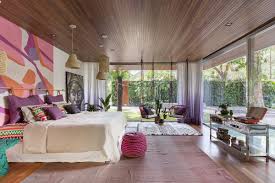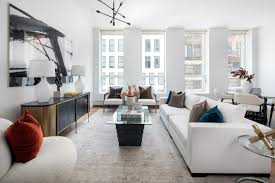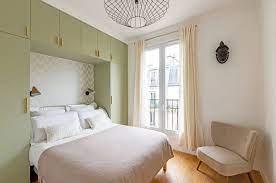Exploring Creative Room Design Ideas
Designing a room is more than just arranging furniture and choosing colors. It’s about creating a space that reflects your personality, style, and functionality. Whether you’re looking to revamp your living room, bedroom, or home office, here are some creative room design ideas to inspire you:
Minimalist Elegance
Embrace simplicity with a minimalist design that focuses on clean lines, neutral colors, and functional furniture. Opt for sleek pieces and declutter the space to create a sense of calm and sophistication.
Bohemian Chic
Add a touch of bohemian flair to your room with eclectic patterns, vibrant colors, and mix-and-match decor. Incorporate cozy textiles, unique accessories, and plants to create a relaxed and inviting atmosphere.
Industrial Vibes
Create an industrial-inspired room with exposed brick walls, metal accents, and raw materials like wood and concrete. Combine vintage elements with modern touches for a stylish urban look.
Nature-Inspired Retreat
Bring the outdoors inside by incorporating natural elements like wood, stone, and plants into your room design. Create a serene oasis with earthy tones, organic textures, and plenty of natural light.
Vintage Glamour
Add a touch of old-world charm to your room with vintage-inspired decor pieces, ornate furniture, and luxurious fabrics. Mix antique finds with contemporary elements for a timeless yet sophisticated look.
Artistic Expression
Showcase your creativity by incorporating art into your room design. Whether it’s paintings, sculptures, or photography, use artwork to add color, texture, and personality to the space.
With these creative room design ideas as inspiration, you can transform any space into a personalized sanctuary that reflects your unique style and taste.
7 Benefits of Creative Room Design: Transform Your Space and Enhance Your Home
- Enhances the aesthetic appeal of your living space.
- Allows for personal expression and creativity.
- Optimizes functionality and organization within the room.
- Creates a welcoming and comfortable environment for relaxation.
- Can improve mood and overall well-being through thoughtful design choices.
- Provides an opportunity to experiment with different styles and themes.
- Adds value to your home by increasing its visual appeal.
7 Common Pitfalls to Avoid in Room Design: Navigating Choices, Trends, and Space Constraints
- 1. Overwhelming choices can lead to decision fatigue.
- 2. Following trends may result in a lack of personalization.
- 3. Limited space constraints creativity and functionality.
- 4. Mixing too many styles can create a disjointed look.
- 5. High-end design elements can be costly and not budget-friendly.
- 6. Bold color choices may become overwhelming over time.
- 7. Lack of proper planning can lead to impractical layouts and inefficient use of space.
Enhances the aesthetic appeal of your living space.
Enhancing the aesthetic appeal of your living space through thoughtful room design ideas can truly elevate the atmosphere of your home. By carefully selecting colors, furniture, decor, and layout, you can create a visually pleasing environment that reflects your personal style and taste. Incorporating elements that complement each other harmoniously can bring a sense of cohesion and beauty to every corner of your room. Whether it’s through minimalist elegance, bohemian chic, industrial vibes, or any other design theme, focusing on aesthetics can transform your living space into a welcoming and visually stunning retreat for both you and your guests to enjoy.
Allows for personal expression and creativity.
Room design ideas offer a wonderful opportunity for personal expression and creativity. By exploring different styles, colors, textures, and layouts, individuals can truly make a space their own. Whether it’s incorporating favorite colors, displaying cherished artwork, or arranging furniture in a unique way, room design allows individuals to showcase their personality and creativity. This freedom of expression not only makes the room visually appealing but also creates a sense of ownership and comfort in the space. It’s a chance to let imagination run wild and create a room that is truly one-of-a-kind.
Optimizes functionality and organization within the room.
Optimizing functionality and organization within a room is a key pro of thoughtful room design ideas. By strategically arranging furniture, storage solutions, and decor elements, a well-designed room can maximize space utilization and enhance overall efficiency. From creating designated areas for specific activities to incorporating clever storage options that reduce clutter, an organized room not only improves workflow but also promotes a sense of calm and productivity. By prioritizing functionality in room design, individuals can enjoy a space that not only looks aesthetically pleasing but also serves their practical needs seamlessly.
Creates a welcoming and comfortable environment for relaxation.
Room design ideas play a crucial role in creating a welcoming and comfortable environment for relaxation. By carefully selecting furniture, colors, and decor elements that promote a sense of tranquility and coziness, a well-designed room can become a sanctuary for unwinding after a long day. Whether it’s incorporating plush seating, soft lighting, or soothing color palettes, the thoughtful arrangement of these design elements can transform any space into a peaceful retreat where one can escape the stresses of daily life and truly relax.
Can improve mood and overall well-being through thoughtful design choices.
Thoughtful room design choices have the power to significantly impact mood and overall well-being. By carefully selecting colors, textures, lighting, and layout, a room can be transformed into a space that promotes relaxation, creativity, and positivity. Incorporating elements that resonate with personal preferences and evoke feelings of comfort and joy can create a sanctuary where one can unwind, recharge, and thrive. Whether it’s introducing natural elements for a sense of tranquility or brightening up the space with vibrant hues for energy, the right design choices can enhance emotional well-being and contribute to a happier and healthier lifestyle.
Provides an opportunity to experiment with different styles and themes.
Room design ideas offer a wonderful opportunity to experiment with various styles and themes, allowing individuals to explore their creativity and express their unique tastes. By trying out different design concepts, from minimalist to bohemian, industrial to vintage, individuals can discover what resonates with them the most and create a space that truly reflects their personality. This freedom to mix and match elements opens up a world of possibilities for creating rooms that are not only visually appealing but also deeply meaningful.
Adds value to your home by increasing its visual appeal.
Enhancing your home with well-thought-out room design ideas not only elevates its aesthetic charm but also adds significant value to your property. By creating visually appealing spaces that are both functional and attractive, you can make a lasting impression on potential buyers or renters. A thoughtfully designed room can showcase the potential of your home, making it more desirable in the real estate market and potentially increasing its resale value. Investing in quality room design ideas is a smart way to enhance the overall appeal and marketability of your home, ultimately leading to a higher return on investment.
1. Overwhelming choices can lead to decision fatigue.
When it comes to room design ideas, one significant con to consider is the potential for overwhelming choices that can lead to decision fatigue. With a plethora of options available for furniture, colors, layouts, and decor elements, individuals may find themselves feeling overwhelmed and exhausted by the decision-making process. This can result in difficulty in making definitive design choices, leading to delays in completing the room design project. To combat decision fatigue, it is essential to establish a clear vision or theme for the room beforehand and prioritize key elements to streamline the decision-making process.
2. Following trends may result in a lack of personalization.
One significant drawback of room design ideas is that following trends too closely may lead to a lack of personalization in the space. While staying current with popular design trends can be inspiring and visually appealing, relying too heavily on what is currently fashionable may result in a room that lacks individuality and fails to reflect the unique personality and preferences of the occupant. It’s essential to strike a balance between incorporating trendy elements and infusing the space with personal touches to ensure that the room feels truly personalized and inviting.
3. Limited space constraints creativity and functionality.
Limited space can pose a significant challenge when it comes to room design ideas, as it can restrict both creativity and functionality. With less room to work with, there is a constant struggle to find ways to maximize the use of space without sacrificing style or comfort. Furniture placement becomes crucial, and innovative solutions such as multi-functional pieces or clever storage options may be necessary to make the most out of limited square footage. Despite these constraints, embracing creativity and thinking outside the box can lead to unique and efficient design solutions that transform even the smallest spaces into functional and aesthetically pleasing environments.
4. Mixing too many styles can create a disjointed look.
Mixing too many styles in room design can lead to a disjointed look that lacks cohesion and harmony. When different design elements clash instead of complementing each other, the overall aesthetic can appear chaotic and overwhelming. It’s important to strike a balance between incorporating diverse styles and maintaining a sense of unity in the room. By carefully selecting complementary pieces and finding a common thread to tie everything together, you can avoid the pitfall of creating a jumbled and disconnected space that lacks visual appeal and coherence.
5. High-end design elements can be costly and not budget-friendly.
When considering room design ideas, one significant drawback to keep in mind is that high-end design elements can often come with a hefty price tag, making them less budget-friendly for many individuals. Incorporating luxurious materials, designer furniture, and upscale decor pieces can significantly increase the overall cost of a room makeover. This limitation may require careful planning and prioritization of design elements to achieve a balance between style and budget constraints. Alternative options such as DIY projects, thrifted finds, or affordable replicas can be explored to achieve a similar aesthetic without breaking the bank.
6. Bold color choices may become overwhelming over time.
One potential drawback of bold color choices in room design is that they may become overwhelming over time. While vibrant hues can add energy and personality to a space initially, their impact may diminish as trends change or personal preferences evolve. Bold colors have the potential to dominate a room and can be challenging to update or tone down without a major redesign. Careful consideration should be given to the long-term appeal and versatility of bold color choices to ensure that they remain visually appealing and cohesive with the overall design scheme.
7. Lack of proper planning can lead to impractical layouts and inefficient use of space.
One significant drawback of room design ideas is the potential for impractical layouts and inefficient use of space when proper planning is lacking. Without careful consideration of factors such as traffic flow, furniture placement, and functionality, a well-intentioned design concept may result in a space that feels cramped, awkward, or underutilized. It is essential to prioritize thoughtful planning to ensure that the room design not only looks aesthetically pleasing but also serves its intended purpose effectively and efficiently.




